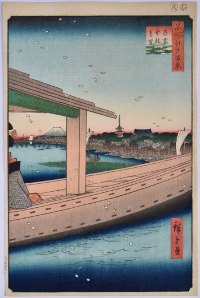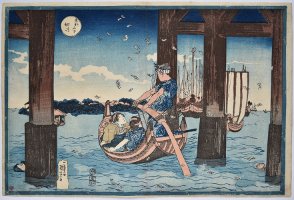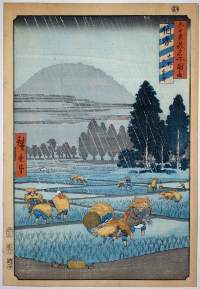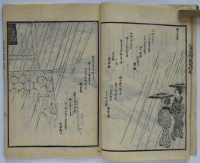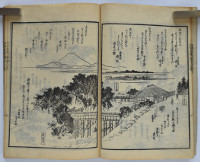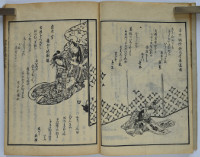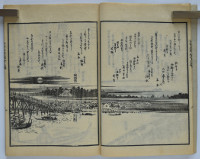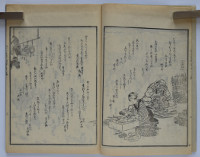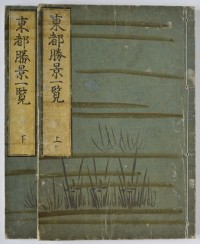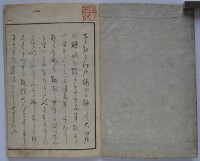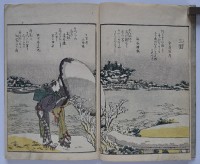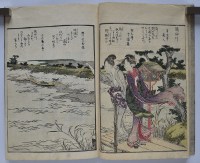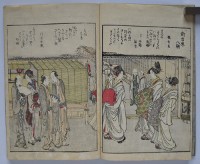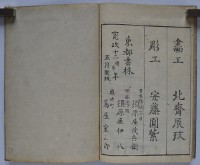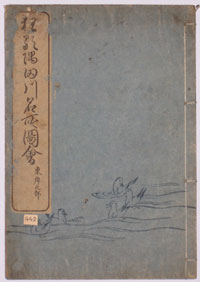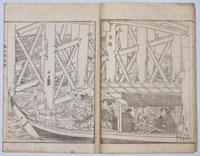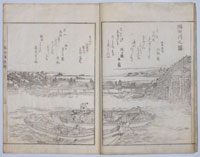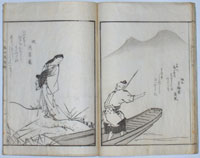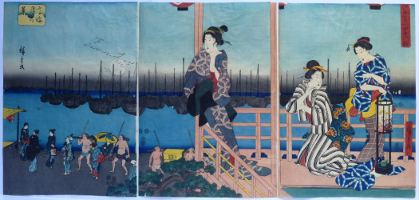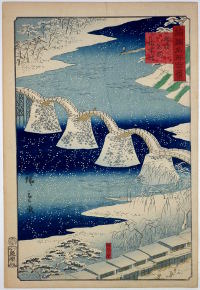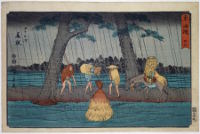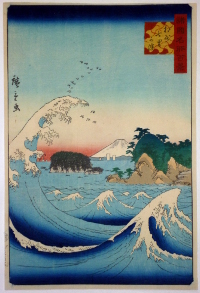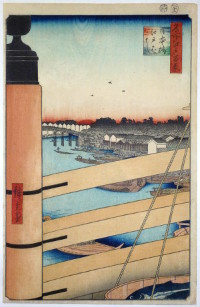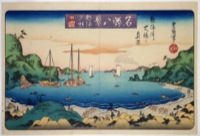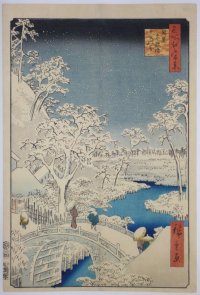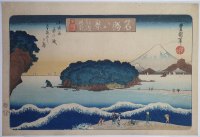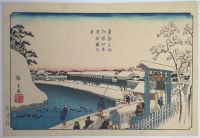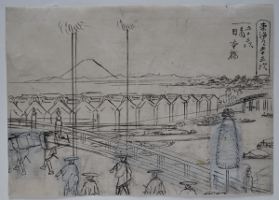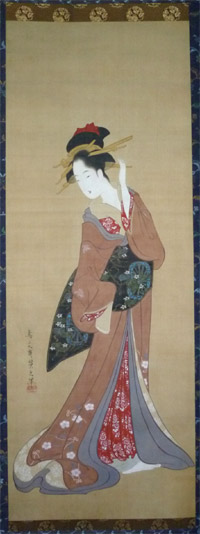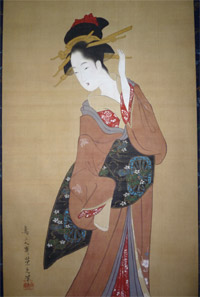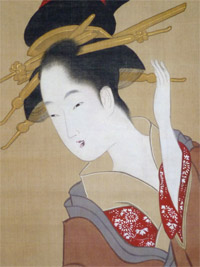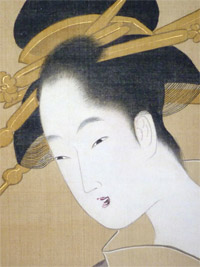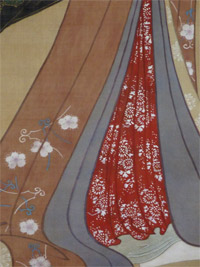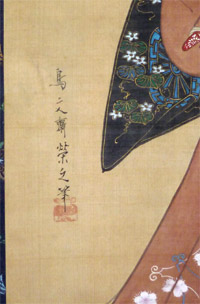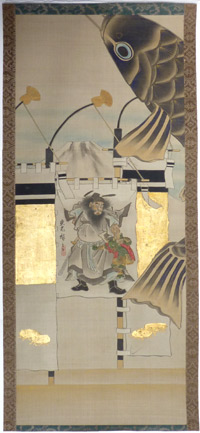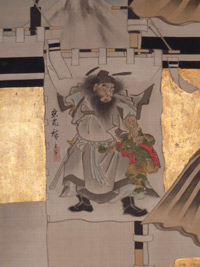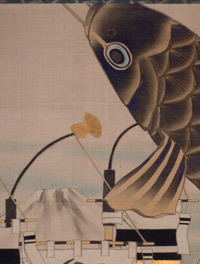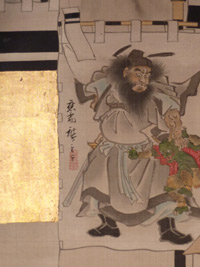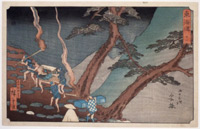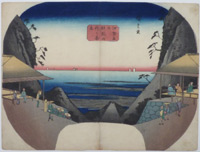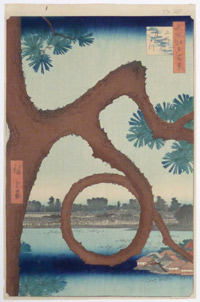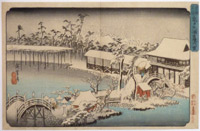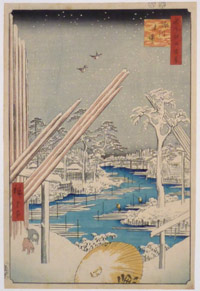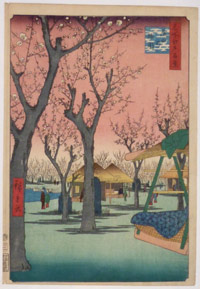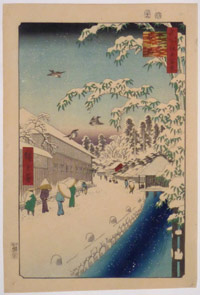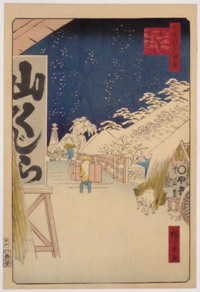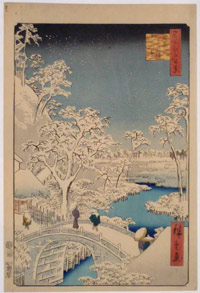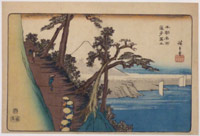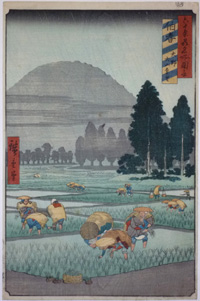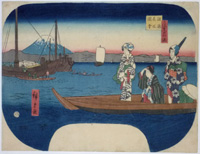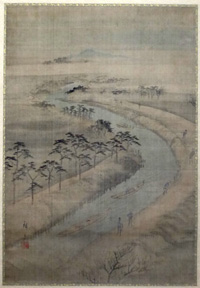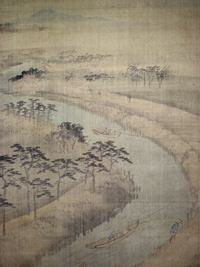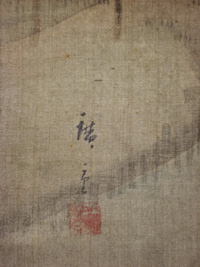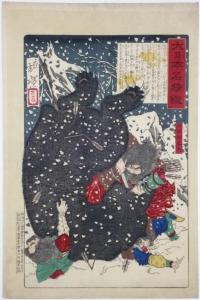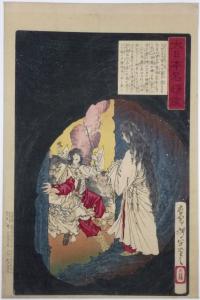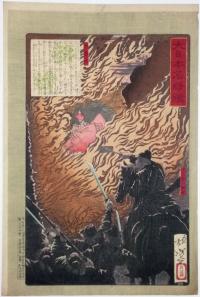Tsukioka YOSHITOSHI (1839-1892)
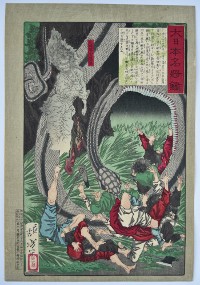
Click here to view image full size.
The serpent Tamichi attacking his enemies from a set of 51 prints Dai Nippon meisho kagami, “A Mirror of Famous Commanders of Great Japan.” The set was published by Ebisuya Shoshichi (the first 11 prints) and Funazu Chujiro between 1878-1882. Like Abe no Hirafu, Tamichi was involved in the subjugation of the Emishi. He was killed by a poisoned arrow but was reincarnated as a giant snake to finally overcome his enemies. Published by Funazu Chujiro in 1880.
Fine, early impression with mica on the snake. Fine colour. Light album backing, otherwise fine condition. Signed Oju Yoshitoshi hitsu.
Status: Sold
Ichiryusai HIROSHIGE (1797-1858)
Click here to view image full size.
Azumabashi Kinryuzan enbo, “Distant View of Kinryuzan Temple from Azuma Bridge” from Meisho Edo hyakkei, the “One Hundred Views of Edo.” The set published between 1856 and 1858 (this being 1857) by Uoya Eikichi. A spring day with cherry blossom floating down over a boat drifting on the Sumida River. A geisha is partly glimpsed sitting in the boat. In the distance is Mt Fuji, the bridge and temple. See my blog.
Superb impression from the first edition. Fine colour. Fine condition. Signed Hiroshige ga.
Status: Sold
Utagawa KUNIYOSHI (1797-1861)
Click here to view image full size.
Tsukudajima from the series Toto meisho, “Famous Places in Edo.” Shows two women and a boatman being rowed beneath Eitai bridge. In the distance is Tsukudajima Island. It was here that large vessels would anchor at the mouth of the Sumida river to transfer their cargos to smaller boats. Devotional prayer slips float down during the Bon Odori festival, 13-15 July, commemorating those that have drowned in the river. A set of ten prints with western influences published by Kagaya Kichiemon, c 1832-3. Ex Kessler collection. Rare.
Very good impression: Early states have a grey tone on the bottom of the bridge supports (as here). A late edition has recut clouds. Slight fading and centre fold, otherwise good condition. The green border intact (so often trimmed off). Signed Ichiyusai Kuniyshi ga.
Status: Sold
Ichiryusai HIROSHIGE (1797-1858)
Click here to view image full size.
A distant view of Mount Daisen [ Oyama ] in Hoki Province. One of the best designs from Rokuju yoshu meisho zue, “Famous Places in the Sixty-Odd Provinces.” The set published by Koshimuraya Heisuke between 7/1853 and 3/1856 ( this being 12/1853 ). White rain ( printed with gofun ) falls on groups of peasants planting rice. A lovely design, the edges of the paddy fields zig-zagging into the distance. This is the rare first edition with blue and yellow diagonal bands on the sub-cartouche.
Fine impression with strong woodgrain showing. The second state of the first edition has the rain printed black (not using gofun as here).Very good colour and condition. Signed Hiroshige ga.
Status: Sold
Tsukioka YOSHITOSHI (1839-1892)
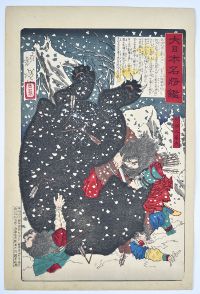
Click here to view image full size.
Abe no Hirafu fighting a giant bear in the snow from a set of 51 prints Dai Nippon meisho kagami, “A Mirror of Famous Commanders of Great Japan.” The set was published by Ebisuya Shoshichi (the first 11 prints) and Funazu Chujiro between 1878-1882. Hirafu was a general for the Empress Saimei. On his return from a mission to the Emishi in northeastern Japan, where he signed a peace agreement , he presented the Empress with two live bears and seventy bear hides. Published by Funazu Chujiro in 1880.
Fine, early impression with splashed gofun (only on the earliest states). Fine colour. Light album backing, otherwise fine condition. Signed Oju Yoshitoshi hitsu.
Status: Sold
Tsukioka YOSHITOSHI (1839-1892)
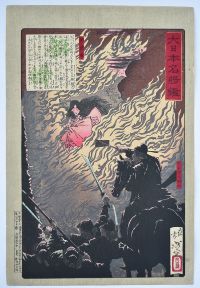
Click here to view image full size.
Yatsunada attacking Saohime’s brother’s castle from a set of 51 prints Dai Nippon meisho kagami, “A Mirror of Famous Commanders of Great Japan.” The set was published by Ebisuya Shoshichi (the first 11 prints) and Funazu Chujiro between 1878-1882. Saohime had conspired with her elder brother Saohikoto to murder the emperor but she abandoned their plan at the last moment. She is seen escaping the conflagration. Published by Funazu Chujiro in 1880.
Fine, early impression. Fine colour. Light album backing, otherwise fine condition. Signed Oju Yoshitoshi hitsu.
Status: Sold
Taiso YOSHITOSHI (1839-1892)
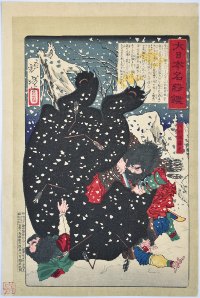
Click here to view image full size.
Shows Abe no Hirafu, a governor of Koshi, killing a giant bear in heavy snow. From a set: Dai Nippon meisho kagami, “Mirror of Famous Leaders of Great Japan.” Published by Funazu Chujiro, 1880.
Fine impression, colour and condition. Signed Oju Yoshitoshi hitsu.
Status: Sold
Utagawa HIROSHIGE (1797-1858)
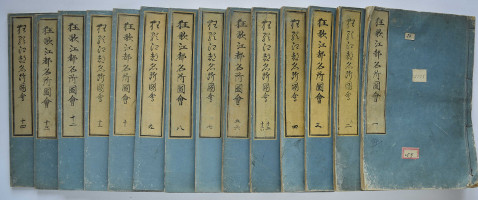
Click here to view image full size.
A complete set of Kyoka Edo meisho zue, “Collection of Pictures of the Famous Places of Edo in Kyoka.” Fourteen volumes (sixteen books) dated Ansei 3, 1856. Artist: Ryusai Hiroshige ga, with volumes fifteen and sixteen being by Hiroshige II. Compiler of poems: Tenmei Rojin. Publisher not given. Book 1: 25 sheets, 11 illustrations. Book 2: 24 sheets, 10 illustrations. Book 3: 23 sheets, 10 illustrations. Book 4: 19 sheets, 9 illustrations. Books 5-6: 34 sheets, 15 illustrations. Book 7: 22 sheets, 9 illustrations. Book 8: 21 sheets, 9 illustratins. Book 9: 22 sheets, 9 illustrations. Book 10: 21 sheets, 8 illustrations. Book 11: 14 sheets, 6 illustrations. Book 12: 18 sheets, 7 illustrations. Book 13: 16 sheets, 6 illustrations. Book 14: 16 sheets, 8 illustrations. Books 15-16: 23 sheets, 9 illustrations. The monochrome illustrations show the popular life of Edo as well as the views. Original covers and title slips.
In very good condition. Rare complete.
Status: Sold
Katsushika HOKUSAI (1760-1849)
Click here to view image full size.
Two volumes complete: Toto shokei ichiran, “Fine Views of the Eastern [Edo] Capital at a Glance.” Shows famous places in Edo with accompanying kyoka poems at the top. Volume 1: 10 sheets, 1 p. preface. Volume 2: 11 sheets with colophon giving date Kwansei 12 (1800). Publishers Tsutaya Jusaburo, Suharaya Mohei and Suharaya Ihachi. Ando Enshi engraver and artist Hokusai shinsei. This book was first published with title Toto meisho ichiran by Tsutaya Jusaburo. Shortly afterwards the title was changed and the two other publishers joined Tsutaya Jusaburo. This is the edition offered here. Original hand-painted covers with a decoration of iris flowers and water (only found on the original edition). The blocks were subsequently sold to the Nagoya publisher Hishiya Kinbei who reissued it in 1815 together with Suharaya Mohei and Ihachi. The blocks were yet again sold, this time to Kawachiya Mohei who issued another reprint in 1840 with the above publishers. A lovely early example of this famous book. Cover and title slips in very good condition.
One wormhole affecting last 4 pages at the top outside image area, otherwise contents fine and clean. Provenance: Large seal of Hayashi Tadamasa at the start to each volume.
Status: Sold
Teisai HOKUBA (177 -1844)
Click here to view image full size.
One volume complete Kyoka sumidagawa meisho zue, ” Humorous Poems on Famous Views of the Sumida River.” Colophon dated Bunsei 6, 1823, published by Shunsuien. Extremely rare.
Original covers with a printed design of chidori. Original title slip. Very good condition.
Status: Sold
Utgawa HIROSHIGE (1797-1858)
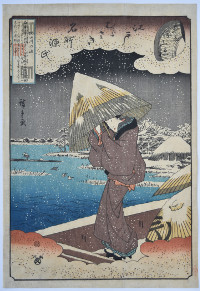
Click here to view image full size.
One of a set: Edo Murasaki meisho Genji, “Murasaki’s Genji in Famous Places of Edo.” Mitate Ukifune Sumidagawa no watashi, “A Parody of Ukifune Crossing the Sumida River.” Shows a beauty on a ferry crossing the Sumida River in heavy snow, representing Ukifune, one of the court ladies of the Genji Monogatari. Stylised clouds above and below copying the traditional kiri-gane gold found on Yamato-e scrolls. These Genji pictures were popular at this time to circumvent the reforms of 1842. Published by Kinseido (his seal also appearing on the umbrella bottom right). A rare set.
Fine impression. Very good colour. Minor soil, otherwise very good condition. Signed Hiroshige ga.
Status: Sold
Ichiryusai HIROSHIGE (1797-1858)
Click here to view image full size.
Autumn from a set of four triptychs, Edo meisho shiki-no nagame, “Famous Places in Edo in the Four Seasons.” An evening scene with beauties on a balcony overlooking the bay at Takanawa. Birds are descending across a full moon. Published by Marujin, 1848-9. All four triptychs from this set are masterpieces.
Fine impression. Perfect colour. Slight thinning and creasing, otherwise fine condition. Signed Hiroshige ga.
Status: Sold
Utagawa HIROSHIGE II ( 1826-1869 )
Click here to view image full size.
Hiroshige II’s best print. Suo Iwakuni no Kintaibashi, “The Kintai Bridge, Iwakuni in Suo Province.” From Shokoku meisho hyakkei, “One Hundred Views of Famous Places in Various Provinces.” Published by Uoya Heikichi 11/1859.
The rare first edition has a variegated sub-cartouche but this is still an extremely early impression with the green on the banks top right ( missing on later editions ); light blue on the water, and gradation and mica on the roofs at bottom. Fine colour. Small repaired binding holes in left margin, otherwise fine condition. Signed Hiroshige ga.
Status: Sold
Ichiryusai HIROSHIGE ( 1797-1858 )
Click here to view image full size.
Fujieda, no. 23, from the so-called Reisho Tokaido because of the formal script used for the title. One of the best designs from the set. Travellers well covered against the rain traversing a path between fields.
Fine impression and colour. Very good condition. Signed Hiroshige ga.
Status: Sold
Ichiryusai HIROSHIGE II ( 1829-1869 )
Click here to view image full size.
The foremost pupil of Hiroshige. Formerly called Shigenobu, he assumed the name Hiroshige II on Hiroshige’s death and married his daughter. Shows Soshu Shichirigahama, the “Seven Ri Beach” near Kamakura, Kanagawa Prefecture. From the set Shokoku meisho hyakkei, “The One Hundred Views of Famous Places in the Provinces.” From the beach one gets a clear view of Fuji and Enoshima Island – both framed by a giant wave. The set ( of which only 80 are known ) was published by Uoya Eikichi 1859-61 ( this being 1859 ).
Very good impression and colour. Margins trimmed close, otherwise very good condition. Signed Hiroshige ga.
Status: Sold
Ichiryusai HIROSHIGE ( 1797-1858 )
Click here to view image full size.
Nihonbashi Edobashi “The Nihon and Edo Bridges from Edo meisho hyakkei, “The Hundred Famous Views of Edo.” The wooden Nihonbashi ( literally Japan Bridge ) was completed in 1603. The current stone bridge dates to 1911. A classic Hiroshige composition using a large foreground object to give depth to the view, further complicated by the insertion of part of a basket of tuna being carried by a porter. Published by Uoya Eikichi between Ansei 3 and 5 ( 1856-58 ). This design dated Snake 12 ( 1857 ).
Very fine impression of the first edition. ( Apart from the three-colour variegated cartouche, only the first edition has gradation on the lower part of the bridge and gradation above and below the boat passing under the bridge. ) Fine colour. Left margin trimmed, otherwise very good condition. Signed Ichiryusai Hiroshige ga.
Status: Sold
Utagawa TOYOKUNI II (TOYOSHIGE ) ( 1777-1835 )
Click here to view image full size.
Evening Glow ( Sunset ) at Atami, Shizuoka Prefecture. From a set Meisho hakkei, “Eight Views of Famous Places” ( based on the Eight Views of Omi theme ). Published 1830s by Iseri. The town is famous for the Onsen hot springs and the area is known for its past volcanic activity. Across Sagami Bay can be seen smoke coming from the volcanic island of Oshima ( the epicentre of the great Kanto earthquake of 1923 ).
Fine impression and colour.There are two states of this set: one with square and one with cursive script ( as here ) in the oblong cartouche at top. It is unclear which is the earliest. This purple cartouche is often faded out to a puce colour. Slight centre fold otherwise very good condition. Signed Toyokuni hitsu.
Status: Sold
Ichiryusai HIROSHIGE ( 1797-1858 )
Click here to view image full size.
A snowy view: Meguro taikobashi yuhi no oka, “Drum Bridge and Sunset Hill, Meguro” from Edo meisho hyakkei, “The Hundred Famous Views of Edo.” Shows the valley of the Meguro River with Sunset Hill to the left. Stone bridges were uncommon in Edo because of the risk from earthquakes. Published by Uoya Eikichi between Ansei 3 and 5 ( 1856-58 ). This design dated Snake 4 ( 1857 ).
Very good impression and colour. Very slight vertical crease, otherwise very good condition. Signed Hiroshige ga.
Status: Sold
Utagawa TOYOKUNI II (TOYOSHIGE) (1777-1835)
Click here to view image full size.
Clearing weather over the Enoshima Island from a Meisho hakkei, “Eight Views of Famous Places” ( based on the Eight Views of Omi theme ) set published 1830s by Iseri. A view of the island from Shichiri Beach in Sagami Province. The island was dedicated to Benten ( one of the seven gods of good luck ).
Fine impression. There are two states of this set: one with square and one with cursive script ( as here ) in the oblong cartouche at top. It is unclear which is the earliest. Fine impression. Small expert restoration to two upper corners, otherwise fine colour and condition. Signed Toyokuni hitsu.
Status: Sold
Ichiryusai HIROSHIGE (1797-1858)
Click here to view image full size.
Soto Sakurada Benkeibori sakura no i, “ The Cherry Tree Well in Snow at Benkei Moat, Sakurada” from a Toto meisho set published by Maruya Seijiro c 1843-45. The outer moat of Edo castle is named after Benkei Shozaeman who undertook the construction during the Kan’ei period ( 1624-1643 ).
Fine impression of the first edition with the Watari censor seal bottom left overprinted in blue and careful gradation above and below on the moat. Fine colour and condition. Signed Hiroshige ga.
Status: Sold
Utagawa HIROSHIGE (1797-1858)
Click here to view image full size.
An important original drawing by Hiroshige being an hanshita-e (preparatory sketch) for an unpublished series Toto meisho gojusan tsugi, “Fifty-Three Views of Edo.” Shows Nihonbashi with a daimyo’s cortege crossing. Warehouses in the background and a distant Fuji.
Probably executed c. early 1850s. Sumi on thin paper, 9.5 x 13.5 in; 24 x 34 cms. Extensive pentimenti. Sold “as is” with imperfections but in good condition. Provenance: Ex Huguette Beres collection, sold Sothebys, Paris, 27/11/2002, lot 177.
Status: Sold
Hosoda EISHI (1756-1829)
Click here to view image full size.
A fine original painting by one of the best known Ukiyo-e artists. This high ranking individual produced some of the most refined prints during the late 1780s and the 1790s. He had many pupils including Eisho, Eiri and Eisui. Shows a standing beauty painted c. late 1790s. One hand adjusts a hairpin, while the other holds a partly concealed letter. Image size 35.25 x 13 in; 89.5 x 33 cms. Exquisitely painted in full colour on silk. In very good condition with futo-maki ( thick wooden roll to preserve the painting from damage ) and fine new mount and box. Signed Chobunsai Eishi hitsu with Eishi seal.
Status: Sold
Ichiryusai HIROSHIGE (1797-1858)
Click here to view image full size.
A fascinating specially commissioned painting by Hiroshige showing a large carp windsock ( koinoburi ) and Boys’ Day banners. Fuji is seen in the distance. The centre banner shows Shoki, the Demon Quellor, exorcising an oni. Shoki images were popular in houses to ward off evil during the Boys’ Day Festival, Tango no sekku, held on the 5th May. The carp was displayed outside homes of families with boys and their strength and character was symbolised by the determination of the carp swimming upstream. See also the print Suido-bashi, Surugadai from the Meisho Edo hyakkei, “One Hundred Famous Views of Edo,” published 1857 where Hiroshige uses the same large carp windsock. Sumi and full colour on silk. Extensive use of gold on the banners, the clouds below and the carp. The eye of the carp lacquered. 28.25 x 11.62 in x 72 x 29.5 cms. Original mount removed. The painting can either be framed and glazed or remounted. Very good condition. Signed Ojyu ( “commissioned” work ) Hiroshige fude. Seal Ichiryusai.
Status: Sold
Ichiryusai HIROSHIGE (1797-1858)
Click here to view image full size.
Hakone from the “Reisho” Tokaido. So-called because of the titles written in formal script. The best Tokaido set after the Hoeido. Shows travellers holding pine-torches climbing a mountain path at night. The Hakone mountains were one of the most gruelling parts of the Tokaido, but at the same time one of the most relaxing with the hot springs, Lake Ashi and the fine cryptomeria trees. Published by Marusei, c 1851-2. One of the five best designs from the set and probably the masterpiece. The composition and use of kimetsubishi to show the woodgrain in the night sky and mountains makes it one of Hiroshige’s most beautiful prints.
Fine impression. Fine colour and condition. Signed Hiroshige ga.
Status: Sold
Ichiryusai HIROSHIGE (1797-1858)
Click here to view image full size.
An uncut fan print from a set of views in Ise: Ise meisho, Asakumayama toge no chamise, “Teahouses on the Mount Asakuma Pass, Famous Places of Ise Province.” Hiroshige used this view about a decade later for his oban tata-e set The 60-Odd Provinces. He cleverly uses the cliff sides to wrap around the uchiwa-e shape. Published c. 1840. Extremely rare. This actual impression illustrated in Hiroshige no uchiwa-e, Unsodo 2010, p. 78, pl. 108. Ex collection Maroni, seal at bottom.
Fine impression and colour. Centre fold, as often, otherwise very good condition. Signed Hiroshige ga.
Status: Sold
Ichiryusai HIROSHIGE (1797-1858)
Click here to view image full size.
The Moon Pine, Ueno, Ueno sannai tsuki no matsu from Edo meisho hyakkei, “The Hundred Famous Views of Edo.” Published by Uoya Eikichi between Ansei 3 and 5 ( 1856 – 58 ), this design being Snake 8 ( 1857 ). Shows Shinobazu Pond, Ueno Park, seen through the ancient pine tree. ( also called the Rope Pine ).
Fine impression of the first edition. Trimmed close and slight fading. Signed Hiroshige ga.
Status: Sold
Ichiryusai HIROSHIGE (1797-1858)
Click here to view image full size.
The Kameido Shrine in snow. The best design from a Toto Meisho set of 21 prints published by Kikakudo ( Sanoki ) c. 1832-5 and then extended to 55 in c. 1839-42. The view shows the famous Drum Bridge, koi ponds and wisteria. The main shrine to the memory of Sugawara no Michizane ( Tenjin ), the father of Japanese learning, and built in 1662.
Fine impression. Probably the first edition with the cloak ( right figure ) and trousers ( left figure ) double printed, red over blue; crisp seal and red publisher’s seal in right margin ( later editions having the black seal of Sanoki ). These later editions have a black sky and a block defect appears at the edge of the pond centre left. Slight centre fold and shaved top right border, otherwise very good condition. Signed Hiroshige ga.
Status: Sold
Ichiryusai HIROSHIGE (1797-1858)
Click here to view image full size.
A snow scene: Fukagawa kiba, “Lumberyard, Fukagawa” from Edo meisho hyakkei, “The Hundred Famous Views of Edo.” Published by Uoya Eikichi between Ansei 3 and 5 ( 1856 – 58 ). This design dated Dragon 8 ( 1856 ). Wood was in strong demand in Edo as there were many fires, indeed, they were called the “flowers of Edo.”
Very good early impression. Fine colour. Lightly backed, otherwise very good condition. Signed Hiroshige ga.
Status: Sold
Ichiryusai HIROSHIGE (1797-1858)
Click here to view image full size.
Kamata no umezono, “Plum Garden at Kamata” from Edo meisho hyakkei, “The Hundred Famous Views of Edo.” Published by Uoya Eikichi between Ansei 3 and 5 ( 1856 – 58 ). This design dated Snake 2 ( 1857 ). A sedan chair is seen to the right in which visitors were carried to the gardens.
Very good early impression. Very good colour and condition. Signed Hiroshige ga.
Status: Sold
Ichiryusai HIROSHIGE (1797-1858)
Click here to view image full size.
A snow scene: Atago shita yabukoji, “Bamboo Lane Below Atago Hill” from Edo meisho hyakkei, “The Hundred Famous Views of Edo.” Published by Uoya Eikichi between Ansei 3 and 5 ( 1856 – 58 ). This design dated Dragon 12 ( 1856 ). The large building on the left housed the daimyo’s servants and retainers.
Fine early impression. Fine colour and condition with mica on roof to right and at base of print. The only discernable difference between this impression and the first state ( apart from the cartouche ) is an extremely subtle gradation on the roofs to left and right. Signed Hiroshige ga.
Status: Sold
Ichiryusai HIROSHIGE (1797-1858)
Click here to view image full size.
Bikunibashi setchu, “Bikuni [ Nun’s ] Bridge in Snow” from Edo meisho hyakkei, “The Hundred Famous Views of Edo.” Published by Uoya Eikichi between Ansei 3 and 5 ( 1856 – 58 ). This design dated Horse 10 ( 1858 ). This area was popular for food stalls and the one on the right advertises baked sweet potato, and the one on the left wild boar.
Very good impression, colour and condition. This design is regarded, by some, as being by Hiroshige II. Signed Hiroshige ga.
Status: Sold
Ichiryusai HIROSHIGE (1797-1858)
Click here to view image full size.
A snow scene: Meguro taikobashi yuhi no oka, “Drum Bridge and Sunset Hill, Meguro” from Edo meisho hyakkei, “The Hundred Famous Views of Edo.” Published by Uoya Eikichi between Ansei 3 and 5 ( 1856 – 58 ). This design dated Snake 4 ( 1857 ).
Very good impression, colour and condition. Signed Hiroshige ga.
Status: Sold
Ichiryusai HIROSHIGE (1797-1858)
Click here to view image full size.
Satta Fuji, “Mount Fuji from Satta.” From the early set of fifteen prints Honcho meisho, “Famous Views of our Country” published by Fujiokaya Hikotaro, c.1837. ( In fact three designs were commissioned in 1832 but the set suspended, only to be resurrected after the success of the first Tokaido series. ) The steep Satta Pass gave a wonderful view of Fuji. Interestingly, the best design from the Thirty-six Views of Mount Fuji, Suruga satta kaijo ( “The Wave” ) gives another view of how wild the sea could be here. Rare.
Fine impression, colour and condition. Signed Hiroshige.
Status: Sold
Ichiryusai HIROSHIGE (1797-1858)
Click here to view image full size.
A distant view of Mount Daisen [ Oyama ] in Hoki Province. One of the best designs from Rokuju yoshu meisho zue, “Famous Places in the Sixty-Odd Provinces.” The set published by Koshimuraya Heisuke between 7/1853 and 3/1856 ( this being 12/1853 ). White rain ( printed with gofun ) falls on groups of peasants planting rice. A lovely design, the edges of the paddy fields zig-zagging into the distance. This is the rare first edition with blue and yellow diagonal bands on the sub-cartouche.
Fine impression with strong woodgrain showing. Fine colour. Margins slightly trimmed and one small sumi smudge, otherwise fine. Another state of the first edition has the grey block and the mountain printed darker. Signed Hiroshige ga.
Status: Sold
Ichiryusai HIROSHIGE (1797-1858)
Click here to view image full size.
Kazusa Kuroto no ura, “The Bay of Kuroto in Kazusa” from a set Shokoku meisho zukai, “Famous Views of the Provinces.” An uncut fan print published by Iseya Soyemon, c 1854. Shows women in a ferry with ships being unloaded in the background and Mount Fuji beyond. Another design from the set is illustrated in Tamba, Hiroshige shodai, 1965, pl. 176. Hiroshige designed a number of fans in collaboration with Kunisada, but these are seldom successful designs as opposed to these “pure” compositions. Rare.
Fine impression and colour and, apart from a small backed hole, in fine condition. Signed Hiroshige ga.
Status: Sold
Ichiryusai HIROSHIGE (1797-1858)
Click here to view image full size.
An important original painting either prior and for the published print Yotsugi-dori, yosui hikifune, “Hauling Canal Boats, Yotsugi Road” from the Meisho Edo hyakkei, published 1857; or painted at the same time because of particular satisfaction with the design. The canal supplied drinking water to the Fukagawa area. It also provided a regular passenger boat service heading northeast. There is some artistic license as the canal was fairly straight, which would not have provided such an interesting composition. Sumi and light blue on thin silk. ( Unique to Hiroshige as he had a penchant for rather coarse silk. ) 24.5 x 16.75 in; 62.25 x 42.5 cms. Good condition. From the collection of a leading supplier of tea ceremony utensils in Tokyo. Signed Hiroshige ga with Ichiryusai seal. ( For the same signature and seal, see Dr Timothy Clark, Ukiyo-e Paintings, B.M., no 141. )
Status: Sold
Ichiyusai KUNIYOSHI (1797-1861)
Click here to view image full size.
The pilot and nobleman Yoshibei leaps from his vessel to a rock in the Chopping Block Shoals and sacrifices himself to save his ship off the coast of Buzen Province. Meisho Kyushu yori joraku no toki. Published c 1850 by Santetsu. A wonderful and rare triptych which is seldom illustrated. Robinson T251.
Extremely fine impression. Fine colour and condition. Totally untrimmed. Colours do not quite match across the three sheets – a common fault on 19th century triptychs. Signed Ichiyusai Kuniyoshi ga.
Status: Sold
Tsukioka YOSHITOSHI (1839-1892)
Click here to view image full size.
Abe no Hirafu slaying a giant bear from Dai Nippon meisho kagami, “Mirror of Famous Generals of Japan.” A set of 51 prints published between 1876 and 1882 by Funazu Chujiro. ( This being 1880. ) Probably the best design from the set.
Very good impression, colour and condition. Full size. Signed Oju Yoshitoshi ga.
Status: Sold
Tsukioka YOSHITOSHI (1839-1892)
Click here to view image full size.
Amaterasu Omikami appearing from the cave from Dai Nippon meisho kagami, “Mirror of Famous Generals of Japan.” A set of 51 prints published between 1876 and 1882 by Funazu Chujiro. ( This being 1882. ) One of the best designs from the set showing the famous story of Amaterasu – the Sun Goddess who had enclosed herself in a grotto with a large rock blocking the entrance causing darkness in the universe. She was tempted to peep out from the cave by the raucous activities of the other gods and goddesses whereupon she glimpsed herself in a mirror and the stone door was quickly fastened back by Ame no Tajikara.
Very good impression, colour and condition. Full size. Signed Oju Yoshitoshi ga.
Status: Sold
Tsukioka YOSHITOSHI (1839-1892)
Click here to view image full size.
Kamitsukeno Yatsunada attacking Saohime’s castle from Dai Nippon meisho kagami, “Mirror of Famous Generals of Japan.” A set of 51 prints published between 1876 and 1882 by Funazu Chujiro. ( This being 1880. ) One of the best designs from the set showing Saohime perishing in the flames of her brother’s castle – Saohiko – who had conspired with his sister to seize the throne.
Very good impression, colour and condition. Full size. Signed Oju Yoshitoshi ga.
Status: Sold
